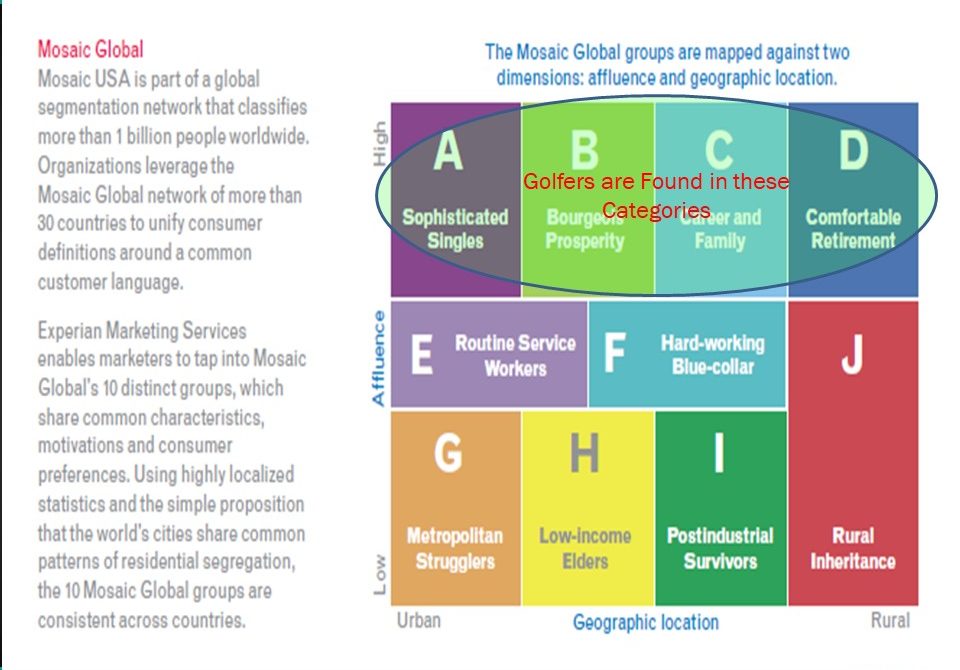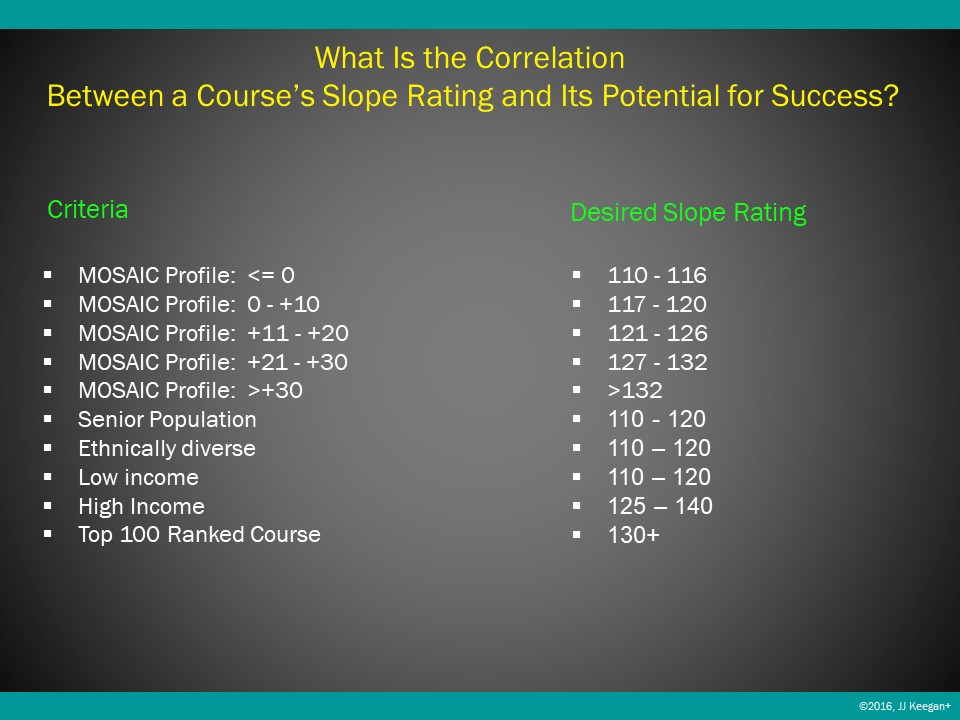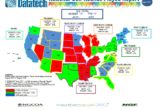
There are two numbers that determine the financial potential of 93% of the golf courses in the United States?
Excluding resorts and exclusive private clubs that attract golfers from hither and yon for the superlative experience offered, the financial success of a golf course is dependent principally upon golfers that live within 10 miles of the course.
Understanding the unique market in which a golf course operates (the underlying demographics of its customers) is fundamental to maximizing its financial potential.
It is our hypothesis, which is being tested under continuing research that continues to validate the theory, there is an ideal type of golf course for each community based on demographics.
The first key number is the relationship of the MOSAIC Profile to the golf course’s slope rating.
Some background knowledge is necessary to understand the importance of this correlation.
The Experian MOSAIC Profile represents a household-based consumer lifestyle segmentation that empowers marketers with the insights needed to anticipate the behavior, attitudes, and preferences of their most profitable customers and how to reach them in the most effective channels with the best messages. Shown below is the Mosaic Global segmentation.
In which groups do the vast majority of golfers emanate from? Our research indicates that nearly 80% of all golfers are classified with the following groups: Sophisticated Singles, Bourgeois Prosperity, Career and Family and Comfortable Retirements.
How then is the MOSAIC Profile Index calculated? One merely needs to compare the concentration of those four segments within 10 miles of your course vs. the general population in the United States which is shown below:
| Category – Global | Adult Population | Percentage | Population | Percentage |
| Sophisticated Singles | 7,247,263 | 3.00% | 8,621,771 | 2.70% |
| Bourgeois Prosperity | 40,634,376 | 16.60% | 50,133,281 | 15.70% |
| Career and Family | 29,162,474 | 11.90% | 42,824,136 | 13.40% |
| Comfortable Retirement | 21,995,782 | 9.00% | 26,247,423 | 8.20% |
| Routine Service Workers | 41,189,454 | 16.80% | 54,889,188 | 17.20% |
| Hard Working Blue Collar | 25,072,838 | 10.20% | 33,184,762 | 10.40% |
| Metropolitan Strugglers | 40,836,086 | 16.70% | 54,732,239 | 17.10% |
| Low Income Elders | 7,583,573 | 3.10% | 8,608,553 | 2.70% |
| Post Industrial Survivors | 17,078,892 | 7.00% | 21,093,231 | 6.60% |
| Rural Inheritance | 14,008,322 | 5.70% | 18,958,458 | 5.90% |
| Total | 244,809,060 | 100.00% | 319,293,042 | 100.00% |
Source: Tactician
To illustrate, if your course is located in located in a neighborhood that the MOSAIC profile index exceeds 20% in relation to the general US population, they are far more probable to have the income and leisure to have been attracted to golf during their lives to become accomplished at the game thus seeking a more challenging golf experience, i.e., higher slope rating. Hence, private clubs and high-end daily fee golf courses are more probable to flourish.
Conversely, if the residents near the golf course are routine service workers or hard-working blue collar, it is more than likely that they haven’t had the life experiences that would facilitate their becoming accomplished golfers. Therefore, a golf course that had a lower slope rating would likely be more ideal for them.
While isolated exceptions to this “guideline” can be found, as a general rule it serves as the first benchmark to measure a golf course’s potential.
Thus, presented below is a chart that outlines the importance of a course’s slope rating to its competitive market:
The second key number calculates the demand vs. supply as measured by the number of golfers per 18 holes within the 10 mile radius. In the US, there are 1,673 golfers per 18 holes. Within the top 100 Core Based Statistical Areas, there are 2,263 golfers per 18 holes.
Based on the number of golfers per 18 holes, which golf course would you like to own from the list of courses presented below:
| Course | Zip Code | State | Golfers/18 Holes Within 10 Miles |
| Marine Park Golf Course | 11234-7007 | NY | 39,046 |
| Redland Golf & Country Club | 33031-1202 | FL | 29,941 |
| Dyker Beach Golf Course | 11228 | NY | 27,331 |
| Forest Park Golf Course | 11421 | NY | 26,995 |
| Liberty National | 07305-4606 | NJ | 25,631 |
| Skyway Golf Course At Lincoln Park | 07306 | NJ | 21,651 |
| Trump Golf Links At Ferry Point Park | 10465-1838 | NY | 21,183 |
| Silver Lake Golf Course | 10301-3701 | NY | 19,825 |
| Bayonne Golf Club | 07002-5070 | NJ | 19,020 |
| The Links At Mustang Creek | 73099-0305 | OK | 17,914 |
| Sydney R. Marovitz Golf Course | 60613-6155 | IL | 15,792 |
| Westgate River Ranch Resort | 33867-1200 | FL | 498 |
| Laconia Country Club | 03246-2382 | NH | 498 |
| Green Lake Campground Golf Course | 54941-9547 | WI | 498 |
| Shaftesbury Glen Golf and Fish Club | 29526-7195 | SC | 497 |
| Twisted Oaks Golf Club | 76230-8513 | TX | 497 |
| Tullymore Golf Club | 49346-8346 | MI | 497 |
| Twin Village Golf Club | 12776 | NY | 497 |
| Fox Hill Golf and Country Club | 13662-6462 | NY | 497 |
| Whitetail Run Golf Course | 16323-7440 | PA | 496 |
| Rolling Greens Golf Club | 62353 | IL | 496 |
| Ubly Heights Golf Course | 48475-9509 | MI | 496 |
Obviously, that golf courses that have an abundance per golfers per 18 holes within 10 miles of their facility have a far better probability of success. Unfortunately, 6,353 (41.8%) of golf courses have less than 1,000 golfers per 18 holes within 10 miles of their facility. Compounding this supply challenge, 5168 (34.0%) of facilities are located where residents living within 10 miles of the golf course spend less than $1,000,000 per 18 holes on golf. Where is the white flag?
These two numbers, the relationship of the MOSAIC Profile to the Slope Rating and the Demand vs. Supply Ratio are the foundation that defines the potential of the golf course.
Sounds complicated, but this conclusion is based on extensive research we have conducted with leading golf managers confirming the theories presented.
Would you like to know what your potential for success is? If you are a daily fee golf course, click here. If you are a municipal golf course, click here.
Upon completing the quiz, you will obtain a grade as to your course’s profit potential. Also, you will receive a 30-minute consultation learning the key numbers that will determine your financial success including:
- Your Mosaic Profile Index score and whether it is ideal considering your slope rating.
- How you ranked out of the 15,204 golf courses in the US as to your profit potential.
- How many golfers per 18 holes live within 10 miles of your golf course and their annual green fee and cart spending.
You can continue to waddle thorough morass of operating a golf course or you can elevate your chances for success by understanding these key strategic benchmarks. The choice is yours and if you are like many golf course, surrendering is on the near horizon unless you adopt a strategic perspective.




Del Ratcliffe
Hi Jim…
Just three observations from me on this one. First you are so dead-on accurate of your analysis of the profit potential of a typical golf operation it is scary; second, I think it is amazing that you offer the quiz and 30 minute consultation – it is a HUGE insight to offer to any course operator in this manner. Finally, I don’t understand why you are not swamped with every course in the country taking you up on this. Good work!
Jack Sauers
Thank you once again for sharing this information. I am headed to work and plan to work on the formula relative to my club. I bought your book last year and think anyone serious about improving their lot in golf course roulette should read it.
Because I am working to improve the bottom line at this club, I am thankful that so many others have not read it!